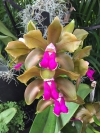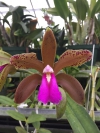|
|
|
|
|
| |
Flasks of
Cattleya bicolor 'A' × sib 'B' |
|
| |
|
|
| |
|
|
Click to Enlarge

Pod Parent Flowers |
Click to Enlarge

Pollen Parent Flower |
|
|
|
| |
Comments: LWG1004
For additional origin/habitat information supplied courtesy of
Charles and Margaret Baker, see further below, near the bottom of this page.
|
Temperatures we attempt to use in the lab & greenhouse:
| For Species: |
|
Spring, Summer, Autumn: days average 81°F, nights 66°F; best fit is Intermediate 83-60°F
(Source:
Baker's Web OSC) |
| For Species: |
|
Winter: days average 74°F, nights 53°F; best fit is Cool 70-52°F
(Source:
Baker's Web OSC) |
| For Genus: |
|
Spring, Summer, Autumn, Winter: days average 83°F, nights 60°F; best fit is Intermediate 83-60°F
(
) |
|
About the name...
| Etymology of |
bicolor |
|
From Latin, two-colored.
(Source:
Mayr & Schmucker 1998) |
| Etymology of |
Cattleya |
|
Named in honor of William Cattley, English horticulturist in the 19th century.
(Source:
Pridgeon 1992) |
| Pronunciation of |
bicolor |
|
BY-col-or
(Source:
Hawkes 1978) |
| Pronunciation of |
Cattleya |
|
KAT-lee-ya
(Sources:
Pridgeon 1992, Hawkes 1978) |
|
If you would like to direct someone to this web page, please copy and paste this URL into your email:
http://troymeyers.com/d?019423
| Flask Information |
| Availability: |
The seeds have germinated in the mother flasks. |
| You should: |
Reserve flasks right now.
Please only reserve if you are committing to purchase the flasks when they are ready later.
We only make flasks for people who request them, so you must make a reservation for us to do the work. If you don't reserve now, there will likely not be enough flasks made to cover your later need. If you wait to reserve until after we begin reflasking into final maturing flasks, then you will lose your place in line. Otherwise, your original notification request acts as your place-holder, keeping you earlier in line. |
| Yield Estimate: |
300 plants (based on flask surveys done 05/31/2023 through 06/27/2023)
|
| Expected Flask Price: |
$40.00 per flask of 16 (min.) plants
Plants proliferate if crowded, so are planted more sparsely than usual.
|
|
You might also want to:
|
View the seed assay for this item.
View items of the same species.
View items of the same genus.
|
| Ordering Information |
| You are not currently logged in. |
|
You must be a registered user and be logged in to reserve a flask or place a notification request. Please log in:
|
|
|
|
|
|
| |
The origin/habitat information below is supplied courtesy of Charles and Margaret Baker
The following information is based on the name of the plant provided by the donor, and assumes that the name is correct. If the plant has been misidentified, then the following information may not be correct.
This text is copyrighted by the Bakers and may not be reproduced without permission.
ORIGIN/HABITAT: Brazil. The habitat includes the coastal mountains between
Rio de Janeiro and São Paulo, and an area between Belo Horizonte and
Formiga. Another population is found further north in the region of
Brasilia.
Plants are now treated as 3 distinct morphologic groups, which are
currently recognized as subspecies bicolor, subspecies minasgeraisensis,
and subspecies brasiliensis.
In addition, Cattleya bicolor has variable flowers, so a name may include
a subspecies designation and then a particular clone name. Each subspecies
originates in widely divergent habitats, so a climate table and habitat
information is included for each subspecies.
More about this information and the Bakers...
|
|
|
| |
|
|
|